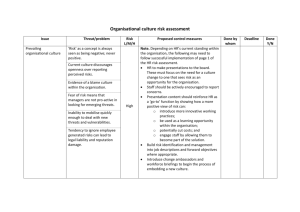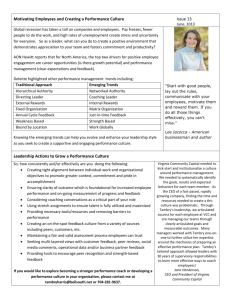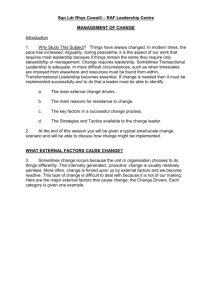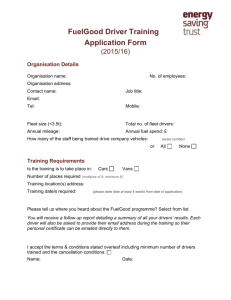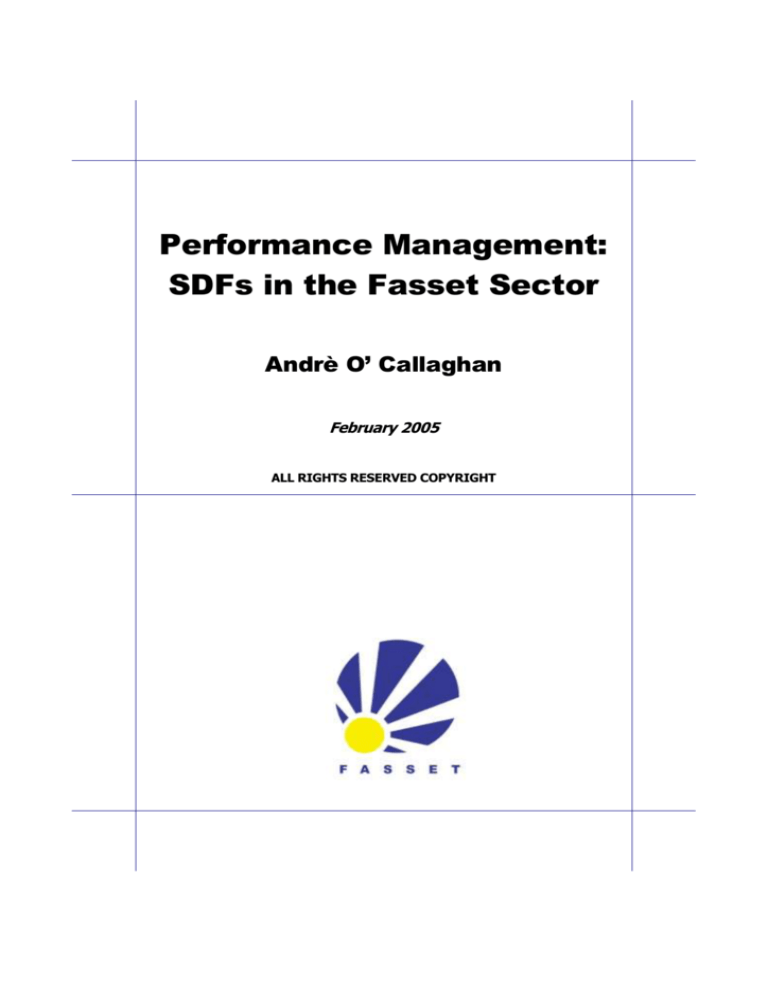
Performance Management:
SDFs in the Fasset Sector
Andrè O’ Callaghan
February 2005
ALL RIGHTS RESERVED COPYRIGHT
INTRODUCTION
“Since my last report, this employee has reached rock bottom and shows
signs of starting to dig.”
“I would not allow this employee to breed.”
“Works well under constant supervision and cornered like a rat in a trap.”
“He sets low personal standards and then consistently fails to achieve
them.”
“This associate is really not so much of a has-been, but more of a definitely
won’t be.”
The above quotes are actual comments made by managers on employees’
performance review forms – although humorous, they illustrate what performance is
NOT!
Performance Management is a key process in any organisation and should assist the
management and staff to focus on the key issues and business objectives to ensure
sustainability.
Performance Management is therefore much more than merely telling a person what to
do and “policing” them until it is done. Rather, it is an integral part of the manager and
the employee’s job – it is a joint process.
The bottom-line reality is that we all need to know what is expected in a specific role –
if that is lacking, uncertainty and frustration, resulting in demotivation and
ineffectiveness, is created. This in turn impacts negatively on company performance
and long-term sustainability of the organisation. To avoid this, clear goals and
objectives need to be defined and that is the crux of an effective Performance
Management system.
PERFORMANCE MANAGEMENT WHAT IS HAPPENING IN SA?
Some perspectives (Deloitte and Touche HCC Survey, 2001):
85% of SA companies have a Performance Management System (PMS).
Performance Management
1
95% of these companies have a strong commitment of the CEO.
In 94% of these organisations, there is a formal communication strategy1
regarding the Performance Management System and Process.
Only 51% of the surveyed companies believe employees and managers are
adequately educated and trained in PMS.
37% use the Balanced Scorecard methodology.
86% allow employees to jointly set targets and objectives with the manager.
91% have clear PMS policies, procedures and systems in place.
Most companies measure performance using hard and soft measures. Hard
measures are quantitative, and often include profit targets, numerical targets,
etc. Soft measures are less quantitative and more qualitative and refer to
behaviours, service levels, etc.
PERFORMANCE MANAGEMENT DEFINED
Performance Management is the process of defining clear objectives and targets for
individuals and teams, and the regular review of actual achievement and eventual
rewarding for target achievement.
The process should ensure that individual and team effort support the organisational
objectives and that key stakeholder expectations are realised by focusing on key value
drivers. Thus:
Planning is crucial
Stakeholder expectations are key drivers of Performance Management
Management and employee buy-in and involvement are paramount
Key objectives and targets should be linked to corporate strategy
These factors are often not addressed in organisations and as a result the process is
often destructive and draws a tremendous amount of energy from the organisation –
leading to a situation where value-add and benefits are minimal.
Performance Management should be a process that incorporates the following:
1
A communication strategy is a methodical and leadership-sanctioned process through whereby key messages are
conveyed to staff via briefing sessions, e-mails, notice-boards, etc.
Performance Management
2
Planning Performance: setting Key Performance Area’s (KPA’s), objectives and
standards that are linked to corporate strategy, development plans
Maintaining Performance: monitoring, feedback, coaching and mentoring and
regular interactions regarding goal achievement
Reviewing Performance: formal feedback and ratings – evaluating performance
Rewarding of Performance: increases, bonuses, incentives, etc
Planning Performance:
Performance Management Model
-Setting objectives
-Outlining development plans
-Getting commitment
Reward Performance:
-Link to pay
-Results = performance
PERFORMANCE
MANAGEMENT
PROCESS
Reviewing Performance:
Maintaining Performance:
-Formal reviews
-Assess against objectives
-Monitoring performance
-Coaching
-Feedback
Business strategy, stakeholders, key economic wealth drivers
Performance Management
3
The Planning Phase is crucial - 80% of time and effort should be allocated to this
phase. If the focus is on inappropriate aspects of the organisation (i.e. the goals do not
contribute to long-term strategy achievement and stakeholder requirements), none of
the subsequent phases will be worthwhile. If the focus is inappropriate, it often leads to
demotivation, lack of credibility and failure of the business.
Planning typically should include the identifying Key Value Drivers of stakeholders
(stakeholders typically are the shareholders, customers and employees of the
organisation).
Schematically the process can be depicted as follows:
Shareholders
STRATEGY
Customers
Employees
KEY VALUE DRIVERS
Once the key value drivers are identified (value drivers are the key aspects that create
economic wealth for the key stakeholders, and can include profitability, quality service,
training, etc), the following is required:
Performance Management
4
KEY VALUE DRIVERS
(Stakeholder Expectations
STRATEGIC
PERFORMANCE AREAS
Key Strategic Objectives
ACTION PLANNING
PERFORMANCE MANAGEMENT:
•WHO (accountabilities)
•WHAT
•WHEN
•HOW (measures)
Performance Management will be effective when a cascading model is followed.
Flowing from the strategy and key value drivers, the following can be defined:
Defining Key Performance Areas (KPA’s)
Defining Objectives
Defining Targets
THE LINK TO TRAINING AND DEVELOPMENT
A key aspect of any good performance management system is training and
development.
Part of the planning phase includes the agreement on a formal development plan for
the employee. Typically this plan should be based on requisite skills, behaviours and
knowledge (key competencies) that will be required to achieve the objectives and
targets set. The development plan can also include long-term developmental initiatives
(usually based on potential, good performance, etc).
Training activities should ideally be based on performance gaps that are identified
during the Maintaining of Performance phase. By linking training to identified
Performance Management
5
performance gaps, training will be focused, specific and relevant. As such,
performance data should be a major input source of the annual training needs analysis.
Desired performance
The “Link”:
Measurement
Actual performance
Development
Vision
Mission
Strategy
Value Drivers
Both the training and development strategy and the performance management process
should be closely aligned with the overall Retention strategy of the organisation.
Research (Teke, M, 2002) suggests that relevant training/development interventions
and regular performance feedback are important factors in skills retention. High flyers
start to look elsewhere for opportunities if these are not present in their working
environment.
BENEFITS OF PERFORMANCE MANAGEMENT
A well-implemented performance management process is beneficial to the company,
its managers and employees. The advantages include:
Integration
Open Communication
Improved Performance
Training and Development
Clarity of Standards/Requirements
Placement of Individuals
Increased Objectivity
Equitable Remuneration
Objective Promotability
Structured Career Planning
Performance Management
6
SELECTING AND EVALUATING A PMS
The following aspects should be considered when you evaluate a new Performance
Management System:
Level of employee participation and involvement?
Is it competency-based? (Competencies refer to the required knowledge, skills
and behaviours that are required to achieve objectives)
Is it form-driven or REAL Performance Management? Form-driven performance
focuses on the completion of the forms and not on the daily feedback and
monitoring
Is it linked to rewards AND development?
Does it focus on both the “what” and the “how” of result achievement?
Does the process incorporate training (both process and soft skills)?
Is it generic, and can it be customised to your organisation’s needs and culture?
Success factors in implementing Performance Management:
Relevance
Link to strategy, clear job goals, up-to-date job profiles
Reliability
Consistent measurement, rating errors
Discriminability
Ability to discriminate between good and poor performance
Freedom from contamination
External factors should not influence measurement (resources, line of sight)
Practicality
Easy to use, understandable, manageable administration
Acceptability
Perceived legitimacy, involvement
Legal compliance
Labour law compliance, Employment Equity Act, substantive and procedural
fairness
Performance Management
7
PERFORMANCE MANAGEMENT AND COACHING
An important role of the manager during the Maintaining of Performance Phase is to
coach the employee in areas that require improvement. Coaching is a formal process.
It is the day-to-day process of helping employees to recognise opportunities to improve
their performance and capabilities. Coaching is therefore an interactive process that
includes guidance, feedback and skill transfer.
We coach because of:
The amount of change that occurs in organisation’s today
To insure that the organisation reaches its performance targets
The fact that continuous learning is now a way of life
We often overcomplicate coaching, and it is often confused with training and other
developmental activities, such as:
Mentoring
On-the-job-training
Sit-by-Nelly interventions (where a less experienced staff member literally
“shadows” a more experienced person and observe his/her daily activities and
tasks to learn new skills)
Job observation
The spirit of coaching is effectively captured in the following quote that is attributed to
the Chinese philosopher, Confucius:
“Give a man a fish a day, and you feed him for a day; teach him to fish, and
you feed him for life”
When you do coaching, you basically need to do the following:
Give feedback, using the EEC Model. The EEC model means that you:
Give an Example
Explain the Effect of the incident (does there need to be an incident?) YES!
Ask for a Change (poor performance) or to Continue (good performance)
Ask for ideas and suggestions instead of telling/instructing
Performance Management
8
Discuss the issue openly and with a flexible approach
Ask the employee the following questions:
Where are you now?
What is happening now?
What are you going to do next?
Coaching therefore provides immediate feedback on performance.
A mentor can be anyone within the organisation, or even from outside the organisation,
and can be either formal or informal. A mentor is a trusted tutor or adviser who plays an
active role in the guidance of the career of an employee.
PERFORMANCE AUDITS
Once Performance Management has been implemented and is in place for a period of
time, it needs to be evaluated in terms of effectiveness and efficiency. An audit in this
case is defined as an investigative, narrative, comparative and analytical process.
Typically
an
audit
can
utilise
any
(or
a
combination)
of
the
following
approaches/methodologies:
Focus groups (focus groups use a representative sample of employees to
determine and discuss perceptions, attitudes, etc).
One-on-one interviews (usually with more senior employees)
Questionnaires (paper-based evaluations, using specific questions)
Document reviews (a formal review of all related documents, i.e. policies, forms,
procedure manuals and training material)
Key topics that should be included in an audit should include:
Is there a formal Performance Management Policy
Training of managers and staff
Clarity and relevance of objectives
Application of the process (consistency)
Understanding and buy-in of the staff
How is it linked to pay
Performance Management
9
The correlation between actual ratings and corporate performance
Once an audit has been done, it is important to communicate the results to employees.
This will contribute towards the credibility and transparency of the system.
PERFORMANCE AND REWARD
Over the past few years South African Corporates have increasingly started to link
reward to performance. “Consequence” management is a term that is used more and
more – the underlying assumption is that direct reward (or the withholding thereof) will
strongly impact on the employee’s motivation to perform better.
The following assumptions often underpin the link between performance and reward:
What gets measured gets done
What gets rewarded is sustained
Measures give rewards relevance, and rewards give measures meaning (TB
Wilson)
The majority of workers want recognition for achievement
Reward has a high retention value
This aspect of the Performance Management process is however very complex and
highly emotional and often fails to deliver the expected positive results. Dilemmas in
reward can often be traced back to issues such as:
Lack of objectivity
Lack of transparency
Affordability
Baggage from previous systems and practices
Performance-based pay and rewards often fail because of the following:
Lack of objective and quantitative measures
Poor link between pay and performance (no immediate reinforcement)
The aspects that get rewarded are not linked to strategy – the “wrong”
behaviours and achievements are sustained
Performance Management
10
Poor communication regarding objectives, benefits and procedures (the “rules
of the game”)
Level of performance-based-pay not proportionate to effort
Resistance to change
Union perceptions and involvement
Important requirements for an effective performance-based reward strategy include:
Establish a pay-for-performance work culture
Ensure employee acceptance
Ensure a clear line of sight
Set high, but attainable standards of performance
Standards should be clear, well defined and accepted
Rewards should be simple and understandable
Effective administration
Rewards for performance can include:
Performance-based increases (annual increments)
Individual and team-based incentives
Performance bonuses
Commissions
Gain-sharing (where staff share in the gains of cost reductions or improved
productivity in the form of cash rewards)
Profit-sharing (where a portion of the profits of a company is distributed
amongst staff, allowing them to share in the financial success of the company)
Employee share ownership plans (ESOP’s)
Suggestion schemes
PERFORMANCE MANAGEMENT IN SMME’S
In the last few years, small, medium and micro enterprises (SMMEs) developed into an
important role player in the South African economy. SMMEs are viewed as a key
source of employment, and one of the objectives of the National Skills Development
Strategy is to stimulate and support skills development initiatives in SMMEs. In view of
Performance Management
11
this, performance management should be an important aspect in SMMEs, but it often is
not applied.
Key challenges in SMMEs that impact on effective performance management include:
Strategy is not always clear, defined or formalised
Decisions are not taken to lower levels (“family business” syndrome)
SMMEs often experience the following dilemma’s:
o
There is little time
o
Few resources and finances
o
Little support
o
Inadequate managerial skills
o
The “we do fine” syndrome
In order to ensure Performance Management is effective in SMME’s, the following can
be considered:
Keep it simple
Make sure you have a formal defined strategy before you implement
performance management
Link the targets of individuals to key business objectives
Where appropriate, make use of available resources (consultants, donor
projects, etc).
CONCLUSION
Effective management of individual and team performance is a crucial and central
requirement to ensure stakeholder requirements, organisational strategy and business
goals are attained. This requires accurate data regarding performance levels of
business units, teams and individuals, and therefore the need for a standardised and
formal performance management system.
An effective performance management system is the centre of an integrated HR
System and the performance data feeds into a variety of processes and systems, for
example:
Performance Management
12
Career planning
Rewards
Training and development
Disciplinary decisions
Promotions, etc …
Despite the importance of performance management, most organisations find it difficult
to implement, manage and sustain performance management systems and processes
effectively. It is therefore crucial to ensure adequate planning, evaluation and training is
done that will support a sustainable process. This is possibly one of the reasons why
performance management systems have evolved and changed significantly over the
years – each new approach an attempt to make it better, more effective and more
acceptable to end-users.
Performance management will remain on the agenda in many corporate meetings, and
will be a key concern for South African HR practitioners and managers for many years
to come.
Performance Management
13
BIBLIOGRAPHY
Bernthal, P, Rogers, R.W & Smith, A. Managing Performance – Building
Accountability for Organisational Success. 2003. Pittsburg, PA, Development
Dimensions International.
Bernthal, P, Sumlin, R, Davis, P & Rogers, B. 2001. Performance Management
Practices Survey Report. Pittsburg, PA. Development Dimensions International.
O’Callaghan, A. 2004. Key Building Blocks of an Effective Performance
Management System. Unpublished paper delivered at an IIL Conference, July.
Teke, M. 2002. Retention Strategy. HR Future. March 2002, 10-12.
SUGGESTED READING & RESOURCES
1. Cusumano, M.A. & Constantios, C.M. Strategic Thinking for the Next Economy.
Jossey-Bass.
2. Johnson. M. Winning the people wars – talent and the battle for human capital.
Financial Times Prentice Hall.
3. Swanepoel, B, Erasmus, B, Van Wyk, M & Schenk, H. 2003. South African Human
Resource Management- Theory & Practice. Juta & Co.
4. www.ddiworld.com
5. www.itofocus.co.za
6. www.pmassoc.com
7. www.zignonperf.com/performance.htm\
Performance Management
14


